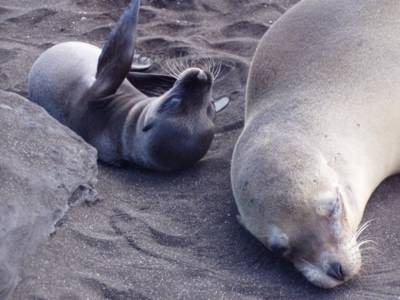After a quick-change on the ship, we headed out to Fernandina Island. It is the youngest and western-most island in the archipelago. It is also extremely active, volcanically. The last eruption was in 1995. Our landing site, Punta Espinosa, was very recently created by an eruption in 1975 . Additionally, the history of Fernandina does not include the introduction of exotic plants and animals. Although people have certainly used this island, it felt the most prisitine of the islands we visited.
Our landing site was crowded with wildlife. We tiptoed around sea lions and their pups as well as marine iguanas. Lava lizards darted here and there. Herons and flightless cormorants were out sunning themselves.


Fernandina had the largest marine iguanas I had seen. And, for the first time, I saw them swimming. It is rumored that they can stay underwater for up to an hour.

Sometimes when they are on land, they would spit. In fact, they were really blowing salt water out of their noses to get rid of excess salt. They also do this to let people know when they are getting too close.


Okay, I like marine iguanas!

The deep black/grey marine iguanas blended in with the new lava. We learned some Hawaiian names for lava. The pahoehoe is also called ropey lava.

Fernandina also boasts wicked large clumps of lava cactus. Our guide, Julian, wanted to take lots of pictures here, so we got to sit a while and commune with the lava and the lava cactus.


Instead of heading directly back to the ship, three of the pangas went chasing after dolphins at top speed. First we headed off to an area with lots of seabird activity overhead - a sign of a good feeding ground, where we might find dolphins. There were large animals arcing through the water, but even at a distance, they didn’t look like dolphins, because there were no fins. As it turns out, these were sea lions. They jumped much higher out of the water than dolphins do, and I thought they were more fun to watch.
Since I live on the west coast of Florida, I get to see lots of dolphins. Consequently, the arcing sea lions held much more appeal for me. But perhaps the naturalists, who live in the Galapagos didn’t think as much of sea lions, who litter the archipelago. So, off we went in search of those elusive dolphins. We eventually caught up with them and enjoyed watching them fish and play.
My Mom and Dad, Tom, TM, and Calliope all missed the dolphin action, due to leaving my Dad stranded on Fernandina with their guide, María del Carmen. They had run out of PFD’s (life vests). Now my Dad has spent a good deal of his life getting separated from the group, due to his strong independent streak. Even on our first excursion in the Galapagos, my Dad somehow turned off the trail, which is pretty hard to do when there are zebra striped trail markers every 50 feet or so and no trees to block the view. Luckily, both María del Carmen and my Dad made it back without being kidnapped by pirates.

No comments:
Post a Comment